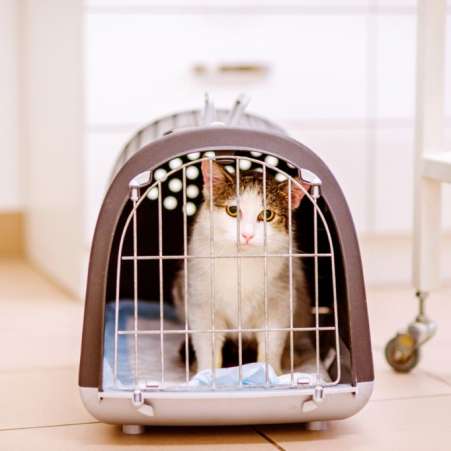Travelling with your Pet
Before you go
Ask yourself: will my cat or dog be comfortable and happy on a trip? Some animals simply prefer to stay at home and a ‘homesick’, possibly motion-sick pet will ruin everyone’s trip. In such a case it’s probably wiser to leave your pet with a friend, relative or hire a ‘petsitter’. If that is not possible, you might consider boarding him at your veterinary clinic or a clean, well-run kennel or cattery.
Plan ahead
If you do decide to take your pet along, you must take as much care with the preparation of your pet’s trip as your own. If you plan to travel by plane or boat, find out if your pet will be welcome and what kind of reservations and transport arrangements must be made. If you’ll be staying at hotels, motels or campgrounds, you must check if animals are allowed or if kennel facilities are available. If you’re staying with friends or family, make sure your pet is also invited.


Travelling by plane
- Contact the airline you wish to fly well in advance – each has its own regulations and reservations for your pet will be necessary.
- Be sure to ask about the airline’s rules for pet crates or carriers.
- Try to book a direct flight or one with a minimum of stops.
- Be at the airport early, place them in their travel crate yourself and pick your pet up promptly when you land.
- Consider contacting a pet transport company who can usually arrange a complete door-to-door service and look after any paperwork required.
Travelling by car
- If your pet is not used to being in a car, take him for a few short rides before your trip. Your cat will probably be safer and more comfortable in a carrier.
- Pets should NEVER be allowed to put their heads outside the window when riding in a car. Dirt particles can cause injury or infections and cold air taken into the lungs can lead to illness.
- Dogs travelling in the back of utes should be either caged or tethered. The lead or chain should be attached to a harness or secure neck collar, with the other end securely fastened to a point near the middle of the cabin. The chain or lead should be of a length that will allow the dog to lie down, stand and move about, but should be short enough so that the dog cannot put its legs over the ute’s sides or climb onto the roof of the cabin.
- Plan ‘snack’, exercise and rest stops about every two hours if you’re taking a long drive.
- Give the main meal at the end of the day. Dry food is more convenient but if your pet needs canned food, dispose of any unused portions if they cannot be refrigerated.
- It is not recommended to leave your dog or cat in a parked car for a prolonged period of time. If you must leave your pet in a parked car, lock all doors and open windows enough to provide good ventilation, without allowing them enough room to jump out or get their head caught. Remember, on hot days, the temperature in a parked car can rise to dangerous levels in just minutes and your pet could die of heat stroke.
Travelling by boat
- Some cruise ships do welcome pets. Check with the cruise line or ask your travel agent.
